|
Graham-Paige
|
1927
- 1962 |
Country: |
 |
|
Robert, Joseph and Ray Graham
The Graham brothers, Joseph B. (September 12, 1882 in Indiana – July 1970 in Indiana), Robert C. (August 1885 in Indiana – October 3, 1967), and Ray Austin (May 28, 1887 in Indiana – August 13, 1932 in Chatham, Ontario, Canada), were successful businessmen, with interests in several industries. Their first business venture was in the manufacture of glass bottles.
It was the Graham brothers who developed the manufacture of glass bottles upside down, which permitted molten glass to build up around the crown. The strengthening of the crown in turn made the bottle strong enough to use a cap instead of a cork. Their glass company eventually became part of the Owens Glass Co., which was itself later to become the "O" in L-O-F.
From there, the Graham brothers began building kits to modify Ford Model Ts and TTs into trucks. That led to the brothers building their trucks using engines of various manufacturers. Eventually they settled on Dodge engines, and soon the trucks were sold by Dodge dealers. The Grahams expanded from beginnings in Evansville, Indiana, opening plants in 1922 on Meldrum Avenue in Detroit, Michigan of 13,000 square feet (1,200 m2), and in 1925 in Stockton, California.
The Canadian market was supplied by the Canadian Dodge plant. Dodge purchased the Graham Brothers truck firm in 1925, and the three Graham brothers took on executive positions at Dodge. In 1927, with the banking syndicate controlling Dodge trying to sell the company, the Graham brothers decided to enter the automobile business on their own.
In 1927, they purchased the Paige-Detroit Motor Company, makers of Paige and Jewett automobiles, for $4 million. The Paige motor company, whose products would henceforward be known as Graham-Paige, had decreed that their profiles, clad in an automotive stylist's idealised concept of chain mail hauberk and helmet, should grace the radiators of the new cars.
In the new company, Robert C. Graham was in charge of sales, Joseph B. Graham was president and Ray A. Graham was treasurer; they, and their guests heavyweight boxing champion Gene Tunney and Notre Dame football coach Knute Rockne, told the assembled motor agents of the new 1928 Graham-Paiges-a range of six-cylinder cars priced between $860 and $2110 - and then harangued them on the advantages of belonging to the Graham-Paige Legion, which had been formed to bring the ideals of medieval chivalry into modern business practice.
Originally, Joseph, Robert and Ray had built cabs and bodies for Dodge trucks in their factory at Evansville, Indiana, but, growing more ambitious, had concluded a deal with Dodge under which they would build complete trucks bearing the Graham name, but using Dodge engines and running gear. So in 1921 they began manufacture in a factory in Detroit, which they were to outgrow twice over the next three years as demand grew. In 1925, Dodge took a controlling interest in Graham Brothers Trucks; shortly afterwards the brothers sold the rest of their stock to Dodge and bowed out of the company.
The Paige-Detroit Motor Company
In 1927 they returned to motor manufacture by acquiring the Paige-Detroit Motor Company, which had originally been founded in 1908 to produce a somewhat eccentric two-seater roadster with a three-cylinder two-stroke engine. Two years later, conventionality prevailed, and a four-cylinder, four-stroke model replaced the earlier design. The car's name was simplified to Paige in 1911; the following year the marque was first exported to England, though judging by the bewildering frequency with which the agency changed hands, the car did not enjoy worthwhile sales in the UK market.
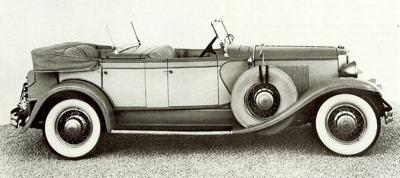 1929 Graham-Paige model 827 dual-cowl phaeton.
1929 Graham-Paige model 827 dual-cowl phaeton.
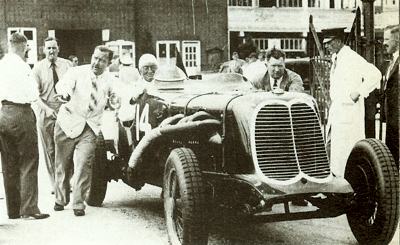 2 Seater Graham-Paige racer circa 1929.
2 Seater Graham-Paige racer circa 1929.
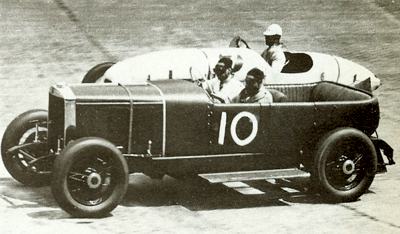 D.M.K. Marendez driving a six-cylinder Graham-Paige in close company with Laystall Special during a 100 mile handicap race at Brooklands in 1929.
D.M.K. Marendez driving a six-cylinder Graham-Paige in close company with Laystall Special during a 100 mile handicap race at Brooklands in 1929.
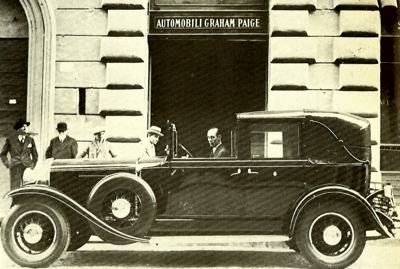 1930 Graham-Paige Coupe de Ville, standing outside the offices of the company's Italian agents. In the previous year Graham-Paige had achieved its most successful year ever, producing 77,077 vehicles.
1930 Graham-Paige Coupe de Ville, standing outside the offices of the company's Italian agents. In the previous year Graham-Paige had achieved its most successful year ever, producing 77,077 vehicles.
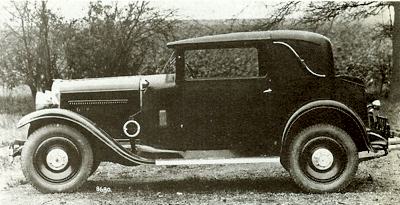 1930 Graham-Paige six cylinder featuring Weymann body.
1930 Graham-Paige six cylinder featuring Weymann body.
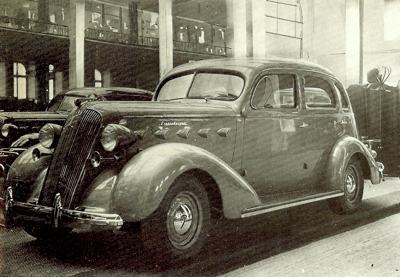 Graham six-cylinder being exhibited at the 1936 Paris Show.
Graham six-cylinder being exhibited at the 1936 Paris Show.
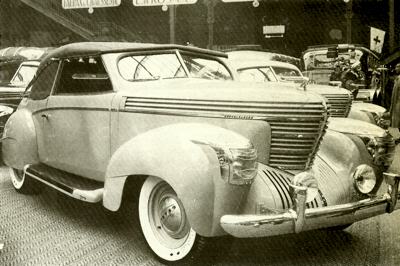 The Graham-Paige 1938 range were all 3.5 liter sixes. The styling was considered a little over the top, even in the streamliner days of the 1930's, and sales were slow.
The Graham-Paige 1938 range were all 3.5 liter sixes. The styling was considered a little over the top, even in the streamliner days of the 1930's, and sales were slow.
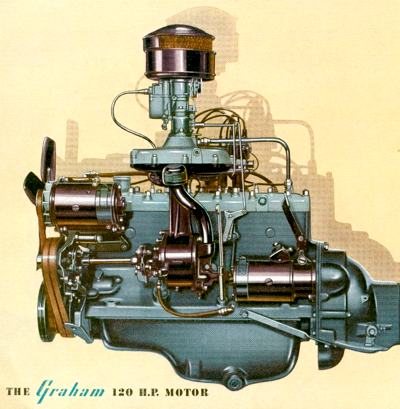 |
In 1914 the Paige agency was held by Byron & Co, of Bloemfontein Avenue, Shepherd's Bush, who were offering the '15hp' (actual RAC rating 22.8hp) and the '20 hp' (25.8 hp) Paiges. It then passed to Mr Masser-Horniman's Mass Car Company in Notting Hill, who lowered the price and renamed the marque Mass-Paige to conceal the fact that their own make of car, built in France to Masser-Horniman's specification, was going out of production.
The Most Beautiful Car In America
On home soil business was much better: the Paige sold in the same price range as such illustrious marques as Hudson, Cadiliac, Oldsmobile and Oakland, and by 1916 the company was doing well enough to have installed a conveyor belt on Ford lines in their factory. The cars had acquired a handsome bull-nosed radiator which, in conjunction with well-styled coachwork, earned the Paige the slogan 'The most beautiful car in America'.
Though the Paige was never more than an assembled car, it had a considerable reputation for sporting performance: most exciting of the company's products was the Daytona Speedster of 1921-1927, named in commemoration of a 102 mph record run by a stripped car of this type on Daytona Beach.
The 8-85 Straightaway Eight
There was also a cheaper line, the Jewett, named after the Company's president, Henry M. Jewett, who is reported to have said, in 1925: 'The weak and inefficient (car makers) are going: larger production and fewer plants are the tendency.' Last of the old-school Paiges was the 8-85 Straightaway Eight, with a Lycoming engine of 5274 cc: this survived the takeover, and was marketed alongside the new Continental-engined sixes, of 3128, 3666 and 4740 cc, which were remarkable for the completeness of their equipment and, like their predecessors, for their performance.
Captain D. M. K. Marendaz, of Marendaz Special fame, who shared the premises occupied by the British Graham-Paige sales company, broke records with a Graham-Paige at Brooklands and Montlhery, and the same car survived as part of the Brooklands scene, endowed with a new racing body, winning the last-ever race in the hands of its owner, G. L. Baker. Another Graham (as the cars became known after 1928) won the 1929 Monte Carlo Rally.
An Assembly Plant in Berlin - Then The Depression
Under the guidance of the three brothers Graham, the Graham-Paige company prospered spectacularly: in 1928 it achieved its highest ever placing in the American sales league, reaching 12th position; the following year, production peaked at 77,077. European demand was sufficient to warrant the opening of an assembly plant in Berlin in 1928: but all this was swept away in the Depression, when few cars were imported, and the company could not even justify the modest expense of a stand at the London Motor Show.
Blue Streak Eights
Despite these setbacks, the Graham-Paige company was the only one of the smaller American car producers to ride out the Depression: and 1932 saw the announcement of a new-style-setting range of Blue Streak Eights with pontoon wings, vee-shaped grille and narrow windscreen, plus an ingeniously low-slung chassis, with the rear axle slotted through the frame side-members. The Blue Streak look was widely copied: but it didn't do Graham-Paige's sales much good; the 1932 figures were 7000 lower than the previous year's. Nevertheless, the company's approach continued to be adventurous.
The 1934 range was crowned by the 4350 cc Custom Eight, which had a centrifugal supercharger driven at five times engine speed by the water-pump shaft. This gave 90 mph plus performance and sparkling acceleration: but though the engine was boosted, sales weren't. At the 1935 Olympia Show, the British agents, Cleverly's Ltd, exhibited the Graham British Special, based on the supercharged eight-cylinder chassis, with various modifications for increased maximum speed and performance, and fitted with an English body more in keeping with English taste. The whole car was equipped for fast touring, and this work was carried out by Bertelli Limited.
The Crusader and Cavalier
Hardly surprisingly, the British Special (available as either a two-door or a four-door saloon, at prices of £685 and £695 respectively) resembled the then current Aston Martin, also part of the Bertelli interests. However, the straight-eight was withdrawn from the market the following spring. From then on, Graham-Paige concentrated entirely on six-cylinder models, the 21.6 hp, 2780 cc Model 74 and the 25.35 hp, 3679 cc Model 74. These were completely restyled for 1936, and the low-priced model was dubbed the Crusader, while the 3.6 liter became the Cavalier.
The body dies of the superseded Special Six were sold to Nissan in Japan, who also used Graham cylinder blocks in building their 1937 Model 70, which marked their entry into the big-car market. A new supercharged six appeared for 1937, characterised by flowing lines; the chassis was used as the basis of the Lammas-Graham, built by Lord Avebury in a little factory at Sunbury-on-Thames. The supercharged Graham power unit was also used in the last Voisin cars, though Gabriel Voisin refused to be associated with this venture, conceived by financiers who had just taken over his company.
By now, it was obvious that the Graham-Paige Corporation was floundering. The 1936 upswing in the American car market as a whole was not reflected in their sales, which were now a quarter of what they had been eight years before. The 1938 range - all 3.5 liter sixes - did little to help, even allowing for the contemporary American predilection for tin-meringue styling, as they were considered surpassingly ugly, with an 'inward-raked snout that looked like the result of a hit-and-run accident'.
To our eyes, we think these cars sensational, the frontal treatment much like a ship passing between two waves. Better still, performance, especially with the optional Vacumatic gear-shift and overdrive, was electrifying. But our opinion was obviously not that of the buying public of the 1930s, and the car was in production for only two years.
Desperate for a winning offering and unable to retool, Graham made a deal with Hupp Motor Co. in late 1939. According to the deal, the faltering company entered into an arrangement with Hupmobile to build cars based on the body dies of the stunning Gordon Buehrig-designed Cord 810/812. In an effort to remain in business, Hupp had acquired the Cord dies, but lacked the financial resources to build the car.
The 1940 Graham Hollywood
The company's last fling was even stranger, for the 1940 Graham Hollywood was built with the body dies from the Cord 810/812 series, also used by Hupmobile: in fact, this Graham was patently a thing of shreds and patches, for it used the Hupmobile chassis as well, only the engine being the real McCoy.
There was still hope, though: during the war, Henry J. Kaiser joined the new president of Graham-Paige, Joseph W. Frazer, in a consortium that would undertake mass-production of cars after the end of hostilities. In 1945 they formed the Kaiser-Frazer Company; the company absorbed the Graham-Paige Corporation and the old factory was taken over for production of Kaiser and Frazer cars.
Graham's manufacturing facilities on Warren Avenue were sold to Chrysler, who used the plants first for DeSoto body and engine production, and finally for assembly of the Imperial for the 1959, 1960, and 1961 model years.
Graham-Paige dropped the "Motors" from its name and went into real estate, buying up such properties as the Roosevelt Raceway in New York and Madison Square Gardens. In 1962, the firm changed its name to the Madison Square Garden Corporation, which was later absorbed by Gulf & Western Industries. Currently Madison Square Garden is part of Madison Square Garden, L.P., of which a majority interest is owned by Cablevision Systems Corporation.
